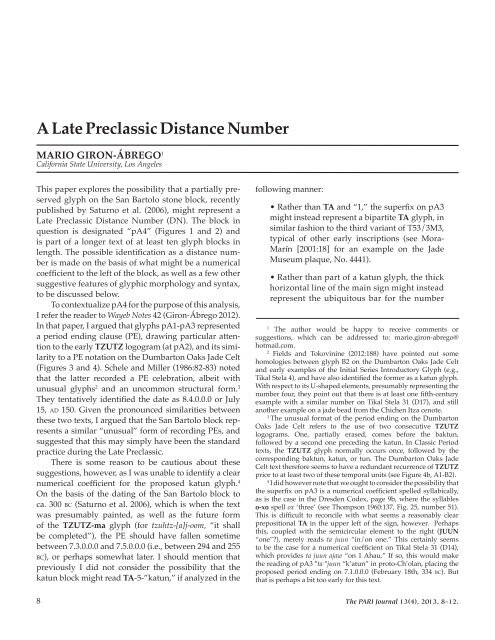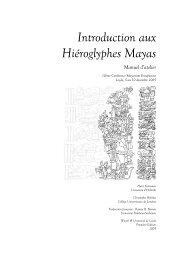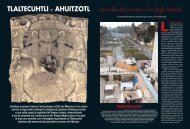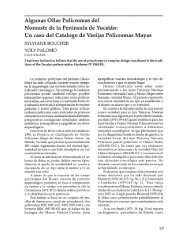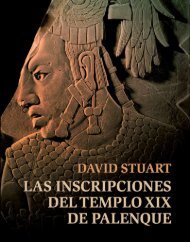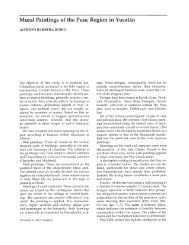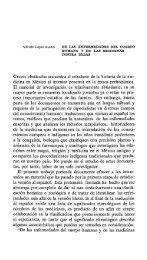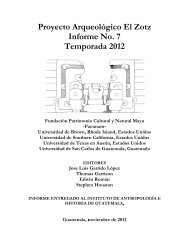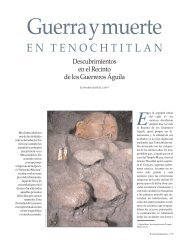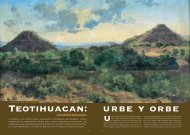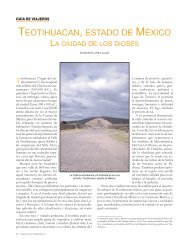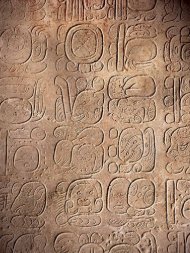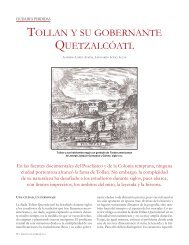A Late Preclassic Distance Number - Mesoweb
A Late Preclassic Distance Number - Mesoweb
A Late Preclassic Distance Number - Mesoweb
Create successful ePaper yourself
Turn your PDF publications into a flip-book with our unique Google optimized e-Paper software.
A <strong>Late</strong> <strong>Preclassic</strong> <strong>Distance</strong> <strong>Number</strong><br />
MARIO GIRON-ÁBREGO 1<br />
California State University, Los Angeles<br />
This paper explores the possibility that a partially preserved<br />
glyph on the San Bartolo stone block, recently<br />
published by Saturno et al. (2006), might represent a<br />
<strong>Late</strong> <strong>Preclassic</strong> <strong>Distance</strong> <strong>Number</strong> (DN). The block in<br />
question is designated “pA4” (Figures 1 and 2) and<br />
is part of a longer text of at least ten glyph blocks in<br />
length. The possible identification as a distance number<br />
is made on the basis of what might be a numerical<br />
coefficient to the left of the block, as well as a few other<br />
suggestive features of glyphic morphology and syntax,<br />
to be discussed below.<br />
To contextualize pA4 for the purpose of this analysis,<br />
I refer the reader to Wayeb Notes 42 (Giron-Ábrego 2012).<br />
In that paper, I argued that glyphs pA1-pA3 represented<br />
a period ending clause (PE), drawing particular attention<br />
to the early TZUTZ logogram (at pA2), and its similarity<br />
to a PE notation on the Dumbarton Oaks Jade Celt<br />
(Figures 3 and 4). Schele and Miller (1986:82-83) noted<br />
that the latter recorded a PE celebration, albeit with<br />
unusual glyphs 2 and an uncommon structural form. 3<br />
They tentatively identified the date as 8.4.0.0.0 or July<br />
15, ad 150. Given the pronounced similarities between<br />
these two texts, I argued that the San Bartolo block represents<br />
a similar “unusual” form of recording PEs, and<br />
suggested that this may simply have been the standard<br />
practice during the <strong>Late</strong> <strong>Preclassic</strong>.<br />
There is some reason to be cautious about these<br />
suggestions, however, as I was unable to identify a clear<br />
numerical coefficient for the proposed katun glyph. 4<br />
On the basis of the dating of the San Bartolo block to<br />
ca. 300 bc (Saturno et al. 2006), which is when the text<br />
was presumably painted, as well as the future form<br />
of the TZUTZ-ma glyph (for tzuhtz-[a]j-oom, “it shall<br />
be completed”), the PE should have fallen sometime<br />
between 7.3.0.0.0 and 7.5.0.0.0 (i.e., between 294 and 255<br />
bc), or perhaps somewhat later. I should mention that<br />
previously I did not consider the possibility that the<br />
katun block might read TA-5-”katun,” if analyzed in the<br />
8<br />
following manner:<br />
• Rather than TA and “1,” the superfix on pA3<br />
might instead represent a bipartite TA glyph, in<br />
similar fashion to the third variant of T53/3M3,<br />
typical of other early inscriptions (see Mora-<br />
Marín [2001:18] for an example on the Jade<br />
Museum plaque, No. 4441).<br />
• Rather than part of a katun glyph, the thick<br />
horizontal line of the main sign might instead<br />
represent the ubiquitous bar for the number<br />
1<br />
The author would be happy to receive comments or<br />
suggestions, which can be addressed to: mario.giron-abrego@<br />
hotmail.com.<br />
2<br />
Fields and Tokovinine (2012:188) have pointed out some<br />
homologies between glyph B2 on the Dumbarton Oaks Jade Celt<br />
and early examples of the Initial Series Introductory Glyph (e.g.,<br />
Tikal Stela 4), and have also identified the former as a katun glyph.<br />
With respect to its U-shaped elements, presumably representing the<br />
number four, they point out that there is at least one fifth-century<br />
example with a similar number on Tikal Stela 31 (D17), and still<br />
another example on a jade bead from the Chichen Itza cenote.<br />
3<br />
The unusual format of the period ending on the Dumbarton<br />
Oaks Jade Celt refers to the use of two consecutive TZUTZ<br />
logograms. One, partially erased, comes before the baktun,<br />
followed by a second one preceding the katun. In Classic Period<br />
texts, the TZUTZ glyph normally occurs once, followed by the<br />
corresponding baktun, katun, or tun. The Dumbarton Oaks Jade<br />
Celt text therefore seems to have a redundant recurrence of TZUTZ<br />
prior to at least two of these temporal units (see Figure 4b, A1-B2).<br />
4<br />
I did however note that we ought to consider the possibility that<br />
the superfix on pA3 is a numerical coefficient spelled syllabically,<br />
as is the case in the Dresden Codex, page 9b, where the syllables<br />
o-xo spell ox ‘three’ (see Thompson 1960:137, Fig. 25, number 51).<br />
This is difficult to reconcile with what seems a reasonably clear<br />
prepositional TA in the upper left of the sign, however. Perhaps<br />
this, coupled with the semicircular element to the right (JUUN<br />
“one”?), merely reads ta juun “in/on one.” This certainly seems<br />
to be the case for a numerical coefficient on Tikal Stela 31 (D14),<br />
which provides ta juun ajaw “on 1 Ahau.” If so, this would make<br />
the reading of pA3 *ta *juun “k’atun” in proto-Ch’olan, placing the<br />
proposed period ending on 7.1.0.0.0 (February 18th, 334 bc). But<br />
that is perhaps a bit too early for this text.<br />
The PARI Journal 13(4), 2013, 8-12.
Figure 1. The San Bartolo stone block in the context where it was<br />
found. Photo by Boris Beltrán, courtesy of William Saturno.<br />
pA<br />
1<br />
2<br />
Figure 3. The Dumbarton Oaks jade celt. Drawing by<br />
Linda Schele, courtesy of David Schele.<br />
pA<br />
3<br />
pA4<br />
?<br />
A1<br />
4<br />
1<br />
B1<br />
5<br />
2<br />
A2<br />
6<br />
7<br />
3<br />
B2<br />
8<br />
9<br />
10<br />
Figure 2. Text on the San<br />
Bartolo stone block, ca. 300 bce.<br />
Drawing by David Stuart (from<br />
Saturno et al. 2006:Fig. 4).<br />
4<br />
a<br />
Figure 4. Comparison of San Bartolo glyphs with Dumbarton Oaks<br />
Jade Celt: (a) glyphs pA2-pA4 from San Bartolo stone block (drawing<br />
by David Stuart); rearranged glyphs A1-A3 of Dumbarton<br />
Oaks Jade Celt from double column to single column (drawing by<br />
Linda Schele, courtesy of David Schele).<br />
b<br />
A3<br />
9
Giron-Ábrego<br />
“5.” 5<br />
pA4<br />
Figure 5. Division of<br />
glyph compound pA4<br />
into affixes. Drawing by<br />
David Stuart.<br />
Prefix<br />
Subfix<br />
Superfix<br />
Main Sign<br />
The pedestal-like subfix would categorize the<br />
glyph compound as a unit of time, a katun in<br />
this case, but not meant to be read phonetically,<br />
similar to the subfix on the Dumbarton Oaks<br />
Jade Celt (B2).<br />
If pA3 indeed records “on (the) fifth katun,” it would<br />
suggest that the PE on the San Bartolo block falls on<br />
7.5.0.0.0 (255 bc).<br />
In my earlier paper, I also suggested that block pA4<br />
in the San Bartolo text (the focus of this paper) may have<br />
served a similar syntactical function as block A3 on the<br />
Dumbarton Oaks Jade Celt (Figure 4), noting some<br />
graphic similarities between the two glyph blocks and<br />
observing that both compounds are still undeciphered.<br />
Fields and Tokovinine (2012:188) have recently<br />
suggested that the PE clause on the Dumbarton Oaks<br />
Jade Celt (A1-B2) is self-containing, and that A3 may<br />
represent the beginning of a new sentence (or clause),<br />
perhaps providing an underspelled verb, or a stative<br />
construction such as “it is,” “there is,” etc.<br />
Along a similar line of thought, I propose that pA4<br />
functions as a transition between two distinct clauses. As<br />
I discuss below, its prefix and superfix might represent<br />
numbers, hence the suggestion that it may represent a<br />
DN. As is well known, DNs can occur after PE clauses<br />
in order to move the narrative forwards or backwards<br />
in time (Kettunen and Helmke 2011:50; Thompson<br />
5<br />
If so, the lack of a glyph for katun itself would perhaps<br />
correspond with the way the earliest contemporaneous Long Count<br />
dates are recorded on monuments such as Chiapa de Corzo Stela<br />
2, Tres Zapotes Stela C, El Baúl Stela 1, Takalik Abaj Stelae 2 and 5,<br />
La Mojarra Stela 1, and the Tuxtla Statuette, where the units of time<br />
are represented only by their corresponding numerical coefficient.<br />
1950:157-180). To pursue this line of thought, I’ve<br />
subdivided block pA4 into units corresponding to our<br />
understanding of Classic Period DNs (Figure 5).<br />
The potential prefix apparently consists of two<br />
dots. Rather than the syllable-doubling diacritic (not<br />
otherwise attested until the fourth century ad), these<br />
dots are suggestive of the coefficient “2,” following the<br />
pervasive bar and dot notation of Maya hieroglyphs<br />
(Thompson 1950:130-131). The superfix, where a second<br />
number would usually be expected in a Classic Period<br />
DN, apparently extends over both the main sign and<br />
the prefix. It does not appear to fall into the bar and dot<br />
numerical classification. Instead, its overall shape is a<br />
silhouette of two squared arches with rounded corners<br />
and a smaller detail infixed between the two. Bearing in<br />
mind the logosyllabic diversity that corresponds to the<br />
“zero” in Maya writing (Blume 2011), I suggest that this<br />
may represent either a calligraphic variant or an early<br />
allograph of T173, perhaps presenting only a portion of<br />
its full form in the pars pro toto principle (Coe 1976). T173<br />
is of course commonplace in Classic Period texts, where<br />
it can be read as MIH/mi “zero.” It is employed as the<br />
number zero in calendrical and mathematical instances,<br />
and as a syllable and negative marker in word formation<br />
contexts (Blume 2011; Grube and Nahm 1990).<br />
The subfix, although almost entirely erased, may<br />
simply be a complementary part of the rectangular main<br />
sign, without qualities that are meant to be read phonetically,<br />
but perhaps identifying the glyph compound<br />
as a unit of time as in the case of the proposed katun<br />
sign.<br />
The main sign is unfortunately rather obscure. Its<br />
internal features include only a central triangle with<br />
a dot to its left and a small horizontal line to its right.<br />
Nonetheless, I am inclined to contemplate that it represents<br />
a suppressed glyph for a unit of time, such as the<br />
“kin-uinal” combination well-known in Classic Period<br />
DNs. In the majority of kin-uinal combinations, the kin<br />
glyph is suppressed and is only inferred by the presence<br />
of its coefficient (Thompson 1950:159). As a general rule,<br />
…the winik coefficient only takes the same space horizontally<br />
or vertically as the winik sign, whereas the k’in coefficient<br />
occupies the whole extent (length or vertical space)<br />
of the remaining glyph block. A worthy piece of advice is<br />
to look at the upper left corner of the glyph block: whatever<br />
number occupies that position is the coefficient of the<br />
k’in period. (Kettunen and Helmke 2011:54)<br />
Assuming these <strong>Late</strong> Classic conventions can be traced<br />
back to a significantly earlier period, the numerical<br />
10
A <strong>Late</strong> <strong>Preclassic</strong> <strong>Distance</strong> <strong>Number</strong><br />
coefficient for days on the San Bartolo block would be the<br />
potential “zero” superfix just discussed, as it appears to<br />
extend into the left corner, covering both the main sign<br />
and the prefix or the whole horizontal space of the glyph<br />
block. The two dots in the prefix, a graphically reasonable<br />
“two,” would correspond to the uinal portion of the<br />
DN, since it covers its vertical space. In other words, the<br />
morphological segmentation of pA4 and the analysis of<br />
its affixes suggests that it begins a new sentence, with<br />
the narrative projected either backwards or forwards in<br />
time. 6<br />
A further clue in support of the presence of both a<br />
PE and a DN on the San Bartolo block might come from<br />
the glyph that immediately follows (Figure 6a). This<br />
glyph has a pronounced formal similarity to the socalled<br />
“Bearded God” glyph (Figure 6b-d). Although<br />
pA5 is partially erased at its upper left, its most<br />
prominent characteristic includes the characteristic<br />
descending curved lines of the Bearded God’s “beard.”<br />
The sign remains undeciphered, but several scholars<br />
have analyzed its contexts and suggested that it represents<br />
either a possessive pronoun or a dedicatory<br />
verb (Chinchilla and Fahsen 1991; Fahsen 1988; Mora-<br />
Marín 2008a:1062-1064). 7 A DN followed by a possessive<br />
pronoun or a verb falls well within the expected<br />
parameters of later Classic-period texts (Kettunen and<br />
Helmke 2011:50).<br />
As matters stand, the segmentation of pA4 into<br />
affixes is suggestive of the probable presence of coefficients.<br />
One of these is almost certainly “two,” another<br />
somewhat less certainly “zero.” Additionally, pA4 may<br />
fall between a PE clause (pA1-pA3) and a Bearded God<br />
glyph providing either a possessive pronoun or a verb<br />
6<br />
In Classic inscriptions, DNs are of course followed by what<br />
are called “Anterior Date Indicators” (ADI) or “Posterior Date<br />
Indicators” (PDI), since they indicate either an earlier date or a later<br />
date with respect to the present narrative timeline, respectively<br />
(see Kettunen and Helmke 2011:54). No ADI or PDI glyphs appear<br />
on the San Bartolo stone block, rendering the narrative’s temporal<br />
projection difficult to discern at present.<br />
7<br />
Stephen Houston (personal communication 2012) cautions<br />
that this sign is very similar to later glyphs for Mam “grandfather,<br />
ancestor,” so absent a clear decipherment all of these suggestions<br />
should be taken under advisement. Chinchilla and Fahsen (1991)<br />
argue for a connection with the “God N” glyph common in ceramic<br />
dedicatory texts, now frequently read T’AB-yi, t’abaay “ascended,<br />
raised, dedicated” (Kettunen and Helmke 2011:100). Mora-Marín<br />
(2008b) specifically relates the San Bartolo glyph to a <strong>Late</strong> <strong>Preclassic</strong><br />
jade pendant (K763 in Justin Kerr’s Mesoamerican Portfolio at<br />
MayaVase.com), reading both as u-ni’ pa’ chan ajaw “the nose/tip/<br />
peak of the Split Sky lord.” Nonetheless, I am more inclined to view<br />
it as an ergative pronoun or dedicatory verb introducing nominal<br />
phrases.<br />
(pA5). Because of the lack of a substantial corpus of <strong>Late</strong><br />
<strong>Preclassic</strong> inscriptions, the present argument is inevitably<br />
exploratory in nature. It is my hope, however, that I<br />
have been able to present sufficient evidence to suggest<br />
that pA4 may represent a <strong>Preclassic</strong> <strong>Distance</strong> <strong>Number</strong>.<br />
If pA4 indeed represents a <strong>Distance</strong> <strong>Number</strong>, then<br />
an interesting implication is the likelihood that the<br />
glyphic complexity well known from Classic hieroglyphic<br />
narratives was already in place by at least the<br />
<strong>Late</strong> <strong>Preclassic</strong> period. At the same time, if the superfix<br />
on pA4 proves to be an early version of the number<br />
“zero,” then it represents the earliest glyphic example<br />
of such a number in Mesoamerica, and arguably one<br />
of the earliest instances in the history of writing where<br />
“zero” appears as an autonomous and independently<br />
employed number (Blume 2011; Ifrah 2000; Kaplan 2000;<br />
Seife 2000).<br />
Acknowledgements<br />
c<br />
a<br />
Figure 6. Comparison of Glyph pA5 to other inscriptions: (a) glyph<br />
pA5 of the San Bartolo stone block (drawing by David Stuart);<br />
glyph A1 from the Yale Jaguar Figurine from the Peabody Museum<br />
(drawing by David Mora-Marín, from Mora-Marín 2008:Fig. 2a); (c)<br />
glyph A4 from the Museo del Jade Fidel Tristán spoon (drawing<br />
by David Mora-Marín, from Mora-Marín 2008:Fig. 2b); (d) glyph<br />
A1 from an unprovenienced jade pendant, no. 753 in Justin Kerr’s<br />
Mesoamerican Portfolio at MayaVase.com (drawing by David<br />
Mora-Marín, from Mora-Marín 2008:Fig. 2c).<br />
I thank James Brady, Stephen Houston, Brian Stross,<br />
Gerardo Aldana and the anonymous reviewers for so<br />
generously taking the time from their busy lives to read<br />
earlier drafts of this paper and for providing comments<br />
and suggestions, as well as objections, from which this<br />
work has benefited considerably. I also thank The Paul<br />
and Daisy Soros Fellowships for New Americans for<br />
their support during the preparation of this paper.<br />
b<br />
d<br />
11
Giron-Ábrego<br />
References<br />
Blume, Anna<br />
2011 Maya Concepts of Zero. Proceedings of the<br />
American Philosophical Society 155(1):51-88.<br />
Available: www.amphilsoc.org/sites/default/<br />
files/6BlumeRevised1550106%20(2).pdf.<br />
Chinchilla Mazariegos, Oswaldo, and Federico Fahsen<br />
1991 Sobre la distribución de un glifo Clásico Temprano en<br />
las inscripciones mayas. In II Simposio de Investigaciones<br />
Arqueológicas en Guatemala, 1988, edited by Juan Pedron<br />
Laporte, Sandra Villagrán, Héctor Escobedo, Dora de<br />
González, and Juan Antonio Valdés, pp. 146-156. Museo<br />
Nacional de Arqueología y Etnología, Guatemala.<br />
Coe, Michael D.<br />
1976 Early steps in the Evolution of Maya Writing. In<br />
Origins of Religious Art and Iconography in <strong>Preclassic</strong><br />
Mesoamerica, edited by Henry B. Nicholson, pp. 107–<br />
122. Latin America Studies Series 31. Ethnic Arts<br />
Council of Los Angeles, Los Angeles.<br />
Fahsen, Federico<br />
1988 Artistas y artesanos en la evolución de la escritura<br />
maya. Anales de la Academia de Geografía e Historia de<br />
Guatemala, Tomo LXII, Enero/Diciembre.<br />
Fields, Virginia M., and Alexandre Tokovinine<br />
2012 Belt Plaque. In Ancient Maya Art at Dumbarton Oaks,<br />
edited by Joanne Pillsbury, Miriam Doutriaux, Reiko<br />
Ishihara-Reiko and Alexandre Tokovinine, pp. 184-<br />
189. Dumbarton Oaks, Washington, D.C.<br />
Giron-Ábrego, Mario<br />
2012 An Early Example of the Logogram TZUTZ at San<br />
Bartolo. Wayeb Notes 42. Available: www.wayeb.org.<br />
Grube, Nikolai, and Werner Nahm<br />
1990 A Sign for the Syllable mi. Reports on Ancient<br />
Maya Writing 33:15-26. Center for Maya Research,<br />
Washington, D.C.<br />
Houston, Stephen D., John Robertson, and David Stuart<br />
2000 The Language of Classic Maya Inscriptions. Current<br />
Anthropology 41:321-356.<br />
Ifrah, Georges<br />
2000 The Universal History of <strong>Number</strong>s: From Prehistory to the<br />
Invention of the Computer. Tr. from the French by David<br />
Bellos, E. F. Harding, Sophie Wood and Ian Monk.<br />
John Wiley and Sons, New York.<br />
Kaplan, Robert<br />
2000 The Nothing That Is: A Natural History of Zero. Oxford<br />
University Press, Oxford.<br />
Kettunen, Harri, and Christophe Helmke<br />
2011 Introduction to Maya Hieroglyphs. Workshop<br />
handbook for the XVI European Maya Conference,<br />
Copenhagen. Department of American Indian<br />
Languages and Cultures, Institute of Cross-cultural<br />
and Regional Studies, University of Copenhagen.<br />
Macri, Martha J., and Matthew G. Looper<br />
2003 The New Catalogue of Maya Hieroglyphs. Volume 1: The<br />
Classic Period Inscriptions. Civilization of the American<br />
Indian Series 247. University of Oklahoma Press,<br />
Norman.<br />
Mora-Marín, David<br />
2001 <strong>Late</strong> <strong>Preclassic</strong> Inscription Documentation Project.<br />
Report to the Foundation for the Advancement of<br />
Mesoamerican Studies, Inc. Available: www.famsi.<br />
org/reports/99049/index.html.<br />
2004 Proyecto documentación de inscripciones del<br />
Preclasico Tardío. Report to the Foundation for the<br />
Advancement of Mesoamerican Studies, Inc. Available:<br />
www.famsi.org/reports/99049es/index.html.<br />
2008a Análisis epigráfico y lingüístico de la escritura maya<br />
del periodo Preclásico Tardío: implicaciones para la<br />
historia sociolingüística de la región. In XXI Simposio<br />
de Investigaciones Arqueológicas en Guatemala, 2007, edited<br />
by Juan Pedro Laporte, Bárbara Arroyo, and Héctor<br />
E. Mejía, v. 2, pp. 1056-1079. Ministerio de Cultura<br />
y Deportes; Instituto de Antropología e Historia;<br />
Asociación Tikal; Fundación Arqueológica del Nuevo<br />
Mundo, Guatemala.<br />
2008b Two Parallel Passages from the <strong>Late</strong> <strong>Preclassic</strong><br />
Period: Connections Between San Bartolo and an<br />
Unprovenanced Jade Pendant. Wayeb Notes 29.<br />
Available: www.wayeb.org.<br />
Saturno, William A., David Stuart, and Boris Beltrán<br />
2006 Early Maya Writing at San Bartolo, Guatemala. Science<br />
311(5765):1281-1283.<br />
Schele, Linda, and Mary Ellen Miller<br />
1986 The Blood of Kings: Dynasty and Ritual in Maya Art.<br />
Kimbell Art Museum, Fort Worth.<br />
Seife, Charles<br />
2000 Zero: The Biography of a Dangerous Idea. Penguin Books,<br />
New York.<br />
Thompson, J. Eric S.<br />
1950 Maya Hieroglyphic Writing: Introduction. University of<br />
Oklahoma Press, Norman.<br />
1962 A Catalog of Maya Hieroglyphs. University of Oklahoma<br />
Press, Norman.<br />
Kaufman, Terrence, and William Norman<br />
1984 An Outline of Proto-Cholan Phonology, Morphology,<br />
and Vocabulary. In Phoneticism in Mayan Hieroglyphic<br />
Writing, edited by John S. Justeson and Lyle Campbell,<br />
pp. 77-166. Institute for Mesoamerican Studies<br />
Publication 9. State University of New York, Albany.<br />
12


